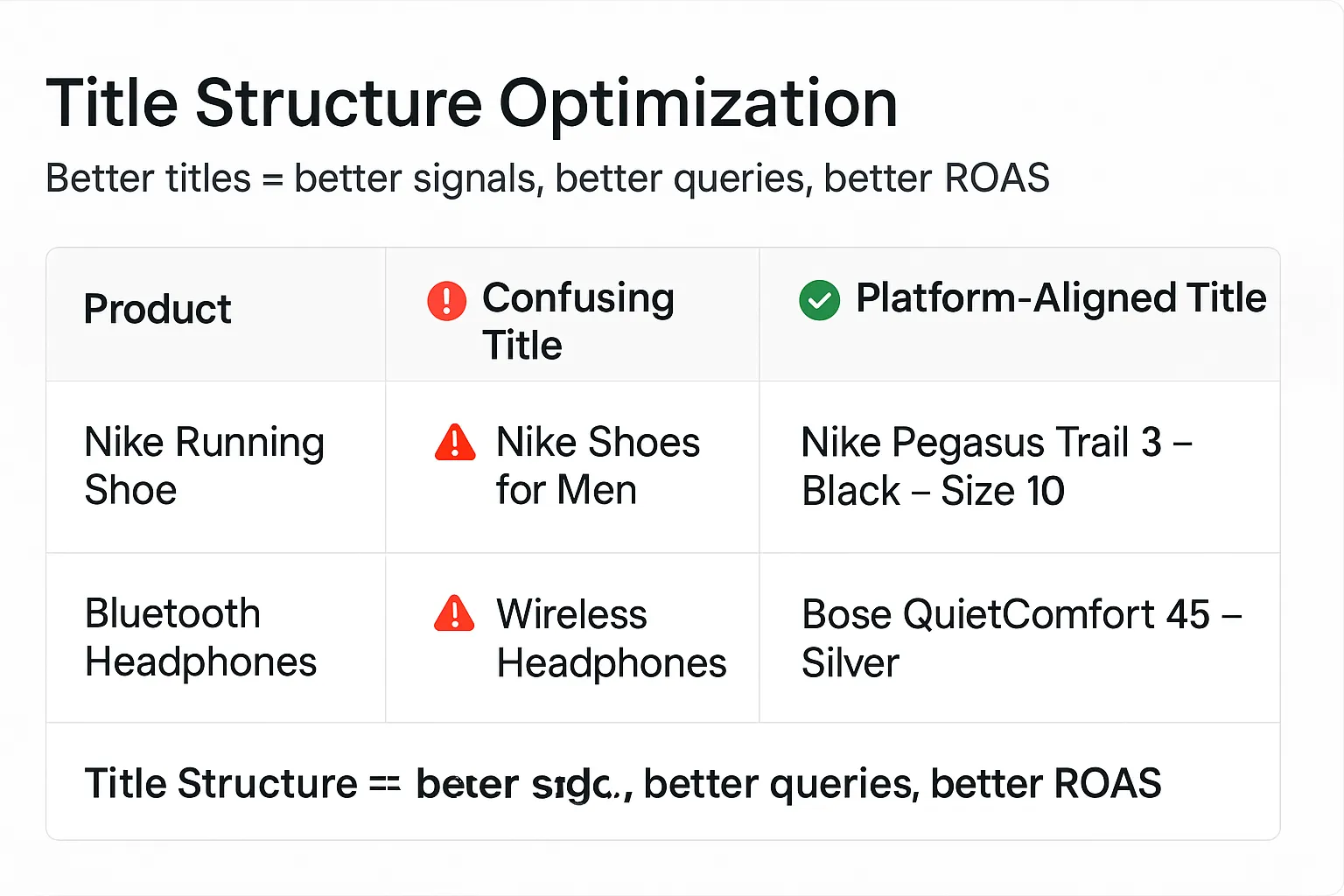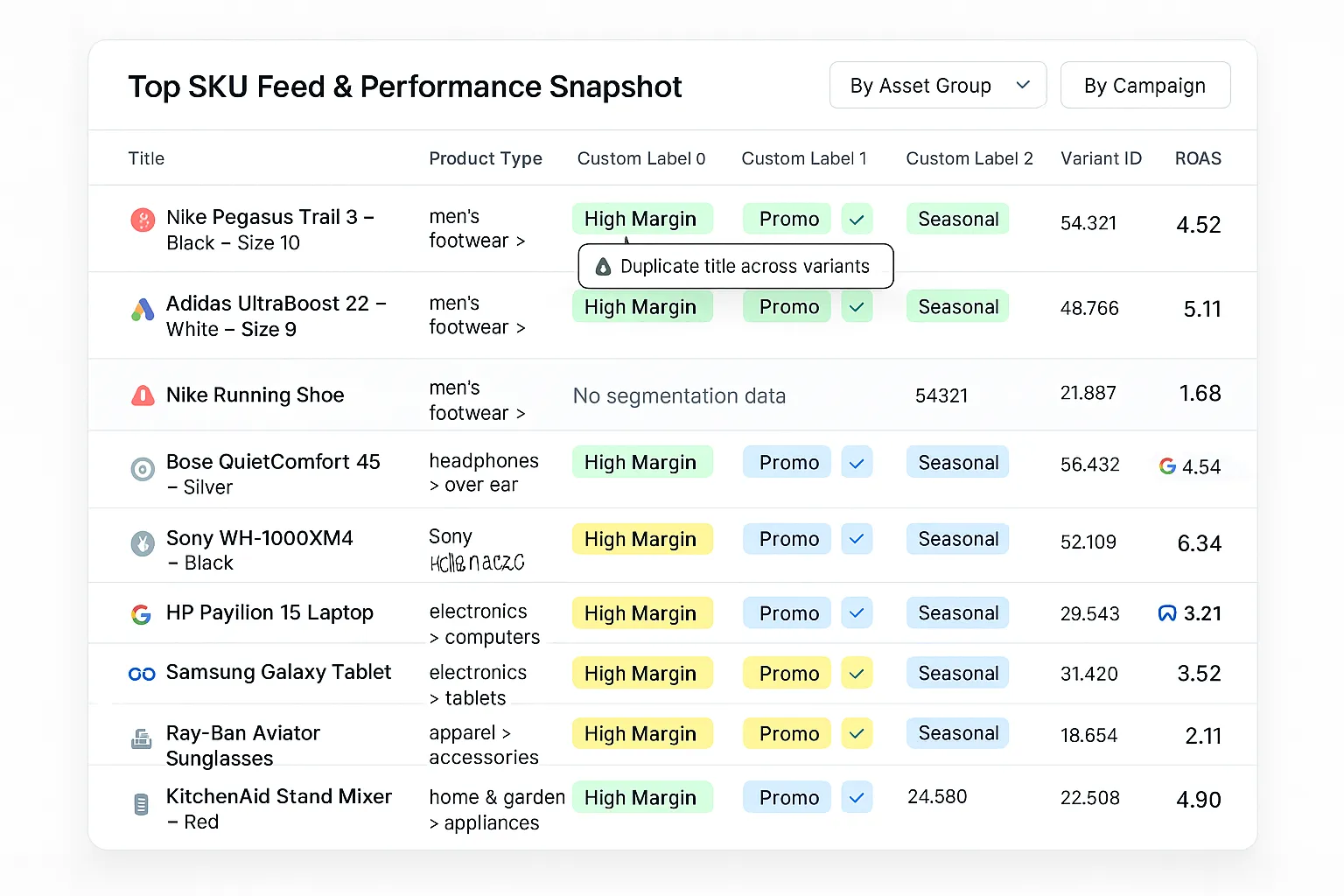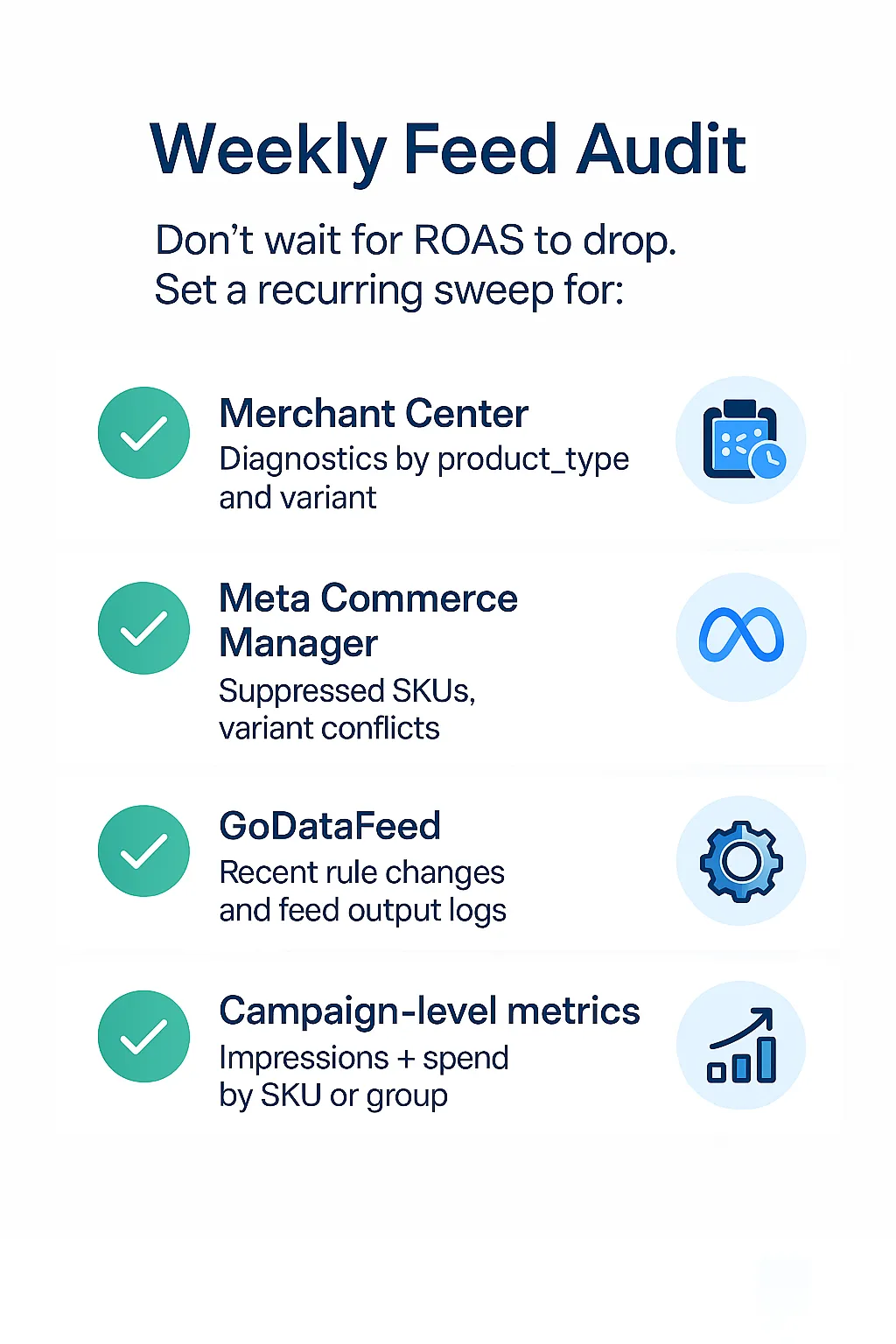Your campaigns aren’t underperforming because of bad ads. They’re underperforming because your feed is feeding them the wrong signals.
Most product feeds pass basic diagnostics. Titles look clean. No disapprovals. Everything “works.” But here’s the truth: clean ≠ strategic. If your feed structure doesn’t match how ad platforms evaluate and serve products, your best SKUs will still lose impressions, your bids will misfire, and your ROAS will bleed.
[The real cost of poor feed structure shows up in platform behavior, not diagnostics.]
This post walks through what most ecommerce teams miss—and how to fix it before your campaign logic gets drowned out by bad feed signals.
Your feed isn’t broken—it’s misaligned with how platforms rank and serve products
The handoff between feed and campaign logic is where most problems start. If operations owns the feed and marketing owns the campaigns, you get mismatched logic. Platform signals get muddy. Campaigns start performing like they were built by guesswork.
Example: In Performance Max, you define asset groups via listing groups. Most teams key those groups to a single feed attribute—often product_type, but brand or custom labels work too. It’s a strategy choice, not a platform rule. Pick one segmentation scheme and stick to it. If your taxonomy mixes broad and deep levels (e.g., “shoes” alongside “running shoes > trail > men’s”), you create overlapping listing groups, weaken asset relevance, and dilute learning signals.
Meta’s just as sensitive. Advantage+ Shopping relies on structured fields like GTIN and product category to make decisions. If your titles are vague or your variants aren’t properly separated, Meta won’t know what to optimize. Result: higher CPAs, wasted budget, and delivery skewed toward the wrong SKUs.
Here’s the part no one flags: feeds can pass Merchant Center and still tank performance. Because platforms care about signal clarity, not just validity.

Bad feed signals trigger good campaign failures
If your hero SKUs lose impressions or PMax starts allocating budget to low-margin products, don’t start with your bids. Start with your feed.
[Feed Rules: Group-by Rules]
Two common causes that don’t show up in diagnostics:
- Google variant sort logic: If your parent-child structure is loose, Google might default to showing the cheapest or first variant—not the one that converts.
- Meta suppression by mistake: A well-meaning rule like “hide low inventory SKUs” can wipe out bestsellers with only a few units left.

And platforms don’t alert you to this stuff. Your top product disappears quietly. Your CPA creeps up. You only catch it when performance is already off.
What you actually want to check:
- Variant-level diagnostics (not just parent SKUs)
- Change logs in your feed tool or CMS
- Weekly deltas in impressions/spend per SKU or asset group
That’s where the real feed damage shows up—buried under “working as intended.”
Once you’ve spotted a drop, the next move is isolating why the feed is failing. Titles are the first thing most teams check—but this is where people get it wrong.
Adding keywords isn’t enough. The goal isn’t keyword density. It’s platform clarity. You’re not writing for SEO—you’re shaping machine understanding.

So the question becomes: what signals is your title sending to Google, Meta, or Microsoft—and are those signals helping your campaign logic or screwing it up?
Keyword-rich titles don’t help if they confuse the platform
Each platform parses feed data differently. Treating all of them like SEO fields is how products end up invisible.
Here’s the short version:
- Google looks for tight relevance between title, query, and landing page. Front-load your titles with real model info, not fluff.
- Meta cares more about structured data than clever wording. If your variants all have the same title, optimization falls apart.
- Microsoft pairs title relevance with taxonomy depth. The platform matches on multiple fields (title, description, category). Keep product_type clean and deep, but don’t downplay titles—a weak title will still hurt matching and ranking.
Tactical fix: Use conditional rules to generate structured, variant-specific titles (pseudo-code—syntax varies by tool).
pgsql
IF size IS NOT NULL AND color IS NOT NULL
THEN title = {Brand} {Product Name} {Color} {Size}
ELSE IF size IS NOT NULL
THEN title = {Brand} {Product Name} {Size}
ELSE IF color IS NOT NULL
THEN title = {Brand} {Product Name} {Color}
ELSE
title = {Brand} {Product Name}
GoDataFeed example (rule-based UI):
- Rule: IF [variant_size] IS NOT NULL AND [variant_color] IS NOT NULL THEN [title] = concat([brand], ' ', [product_name], ' ', [variant_color], ' ', [variant_size])
- Channel nuance: Use conditional override rules per channel so Marketplace A can show “[Brand] [Model] [Color] [Size]” while Google keeps “[Brand] [Model] [Size]”.
- Guardrails: Include model/MPN where relevant, and avoid duplicate titles across variants to prevent self-competition.
Custom labels are campaign instructions—start treating them like it
Most feeds waste custom labels on “Sale” or “New Arrival.” That’s not segmentation. That’s tagging. What you actually want are labels that reflect campaign logic:
- custom_label_0 = margin tier (high / med / low)
- custom_label_1 = clearance or promo eligibility
- custom_label_2 = seasonality signal (based on recent trend or sell-through)
- custom_label_3 = top sellers (last 30-day velocity)
- custom_label_4 = fulfillment speed (1-day / standard / backorder)
[These custom label-driven bidding strategies align your feed structure with margin control, promotions, and campaign intent.]
What this unlocks:
- PMax asset groups grouped by profitability—not just category
- Meta catalog sets aligned to fulfillment speed or promo status
- Microsoft campaigns with flexible bidding logic based on lifecycle stage
[Most ecommerce teams underuse custom labels entirely—a mistake that tanks campaign control.]
If your feed doesn’t segment for campaign structure, your campaign manager has to do it manually—or worse, not at all.
Smarter feed management is responsive, not static
If your feed looks the same mid-season as it does during BFCM, that’s a problem. Smart feed logic adapts to campaign reality. Examples:
- Suppress SKUs with inventory <3 units to avoid low-availability penalties
- Auto-tag SKUs with rising return rates (based on feedback loops)
- Surface seasonal SKUs when weather or search trends spike—especially around seasonal promos
- Update titles dynamically to reflect promos or giftability windows

Related reads:
[https://www.godatafeed.com/blog/data-feed-tactics-to-boost-sales-fall]
Tighten these rules and you’ll see cleaner matching, fewer internal collisions between variants, and steadier CPA—without touching bids. Keep going; the next section shows how this rolls up into campaign structure.
With GoDataFeed, this becomes manageable:
- Build conditional override rules per channel
- Run daily automations without touching source data
- Deploy feed structures that shift based on promo calendars or stock velocity
[Dynamic shifts like inventory-based suppression or seasonality triggers run through conditional feed rule operators.]
This is the difference between a static feed and a performance-layered feed.
Feed decisions are campaign outcomes
You can’t talk ROAS if your feed structure is sabotaging asset groups. You can’t fix CPA if your variants are fighting each other for budget.

Example: You set up 5 PMax asset groups based on listing groups keyed to product_type. But your taxonomy has overlap like:
- “shoes”
- “running shoes”
- “men’s footwear > running”
Now your SKUs get split across groups. Signals fragment. Bidding logic learns slowly. Reporting gets messy. And worst of all, you’re competing with yourself.

What to do:
- Normalize your taxonomy (3–4 tiers max)
- Use feed rules to rewrite inconsistent product_type values
- Align campaign segmentation to clean, non-overlapping categories
This is where feed logic becomes campaign logic. Clean it up and your campaigns stop leaking value.
What to check weekly
Don’t wait for ROAS to drop. Set a recurring sweep for:
- Merchant Center → Diagnostics by product_type and variant
- Meta Commerce Manager → Suppressed SKUs, variant conflicts
- GoDataFeed → Recent rule changes and feed output logs
- Campaign-level metrics → Impressions + spend by SKU or group
Look for spikes, drops, and inventory changes that silently reshuffle your feed structure. That’s where most “sudden” performance shifts start.

Bottom line
If you don’t manage your feed with the same intent as your campaigns, you’re gambling on default platform logic to deliver performance. That never works.
Next move: Grab your top 10 SKUs. For each one, check:
- Does the title clearly identify variant and model?
- Is product_type structured and campaign-aligned?
- Do custom labels give you bidding and segmentation control?
- Is this the variant that should be winning impressions?
If not—fix it. That’s the fastest way to stop your ROAS from leaking.






%20).webp)